During the 1930s, America ranked among world leaders in high-speed rail way service. In 1934, both Union Pacific and Chicago, Burlington & Quincy debuted revolutionary new streamlined, diesel-electric, articulated trains capable of running at more than 100 miles per hour. A year later Milwaukee Road introduced its famous Hiawatha, a high- speed passenger service between Chicago and the Twin Cities using highly refined, conventional, reciprocating steam locomotives. The Hiawatha regularly operated at 110 miles per hour and was capable of slightly faster speeds.
After World War II, railroad passenger travel declined rapidly as people largely abandoned rains in favor of automobile and airline travel.
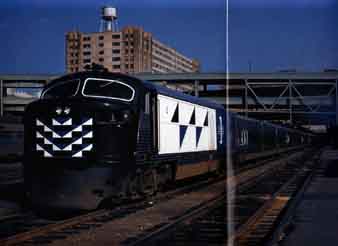
Lightweight articulated trains are nothing new.
Since the 1930s American railroads have experimented with lightweight
articulated trains as means of providing better, faster service. In the
late 1950s Boston & Maine, and New Haven imported Spanish Talgo trains.
It was a novel concept but short lived. The B&M Talgo is seen at
North Station, Boston on July 3, 1959.
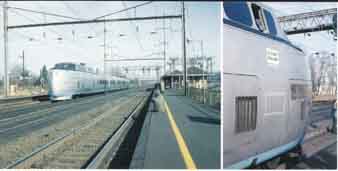
In the 1960s the U.S. federal government provided money for
high-speed train designs. United Aircraft developed its Turbotrain using
aircraft technology. The Turbotrain is seen testing on the Pennsylvania
Railroad in 1967. During trials it was brought up to a maximum of 171
miles per hour. Turbotrains worked for a few years on the Boston to New
York run and were employed with greater success in Canada, but were ultimately
replaced by other trains.
Furthermore, a tragic accident on the Burlington in 1947 resulted in the imposition of a national railway speed limit of just 79 miles per hour, unless a railway line featured advanced protective signaling systems. While some railroads had such systems in place, few were interested in making such an investment.
The railways’ decline was exacerbated by the advent of a federally funded interstate highway system, which got underway in the 1950s, and the introduction of commercial jet airline service. By the 1960s, it appeared that America might soon abandon rail travel entirely with the exception of some suburban commuter networks.
One of the few places where railway travel demonstrated its strengths was in the heavily populated Northeast Corridor between Boston, New York, and Washington, D.C. Here a high population concentration and well-developed mass transit systems made railway travel appealing. This region historically supported an extremely high volume of passenger service. The Pennsylvania Railroad (PRR) had been the most heavily traveled American railroad for many years. In the 1930s, using both public and private funds, PRR developed its New York—Washington mainline into one of the most advanced railway routes in the world, equipping the line with high-voltage AC electrification and multiple-aspect cab signals, permitting operations in the 100- to 110-mile per hour range.
In 1965, inspired by the Shinkansen in Japan, the federal government authorized funding for the development of high-speed railway technology, principally for the Northeast Corridor. As a result, moderately high-speed service was introduced in the late 1960s, with electrically-powered Metroliners reaching a top speed of 120 miles per hour in regular service on the route south from New York. Gas-turbine-powered Turbotrains for the route north to Boston reached speeds of nearly 100 miles per hour.
The catastrophic financial collapse of Penn-Central, the gargantuan and notoriously inefficient railroad created in the late 1960s from the merger of the Pennsylvania, New York Central, and New Haven railroads, resulted in the creation of Amtrak (the National Railroad Passenger Corporation) by the federal government in 1971. Amtrak was designed to relieve the U.S. railroads of mounting passenger deficits. (Later the government picked up the remains of the bankrupt Northeastern freight carriers with the creation of Conrail in 1976.) By virtue of its role as America’s intercity passenger carrier, Amtrak inherited both the Metroliners and Turbotrains. The social and political climate in the 1970s was not yet conducive to true high-speed railway development, however. While Amtrak has maintained comparatively high-speed service on the Northeast Corridor—boosting the maximum running speed to 125 miles per hour in some places—neither of these promising technologies had the opportunity to mature, and future high-speed rail efforts have relied heavily on imported technology.
The traditional Metroliners were an adaptation of conventional American multiple-unit technology and a virtual cousin of the Series 0 trains used on the Shinkansen (sans characteristic aerodynamic streamlining). Amtrak removed the original Metroliner trains from high-speed Northeast Corridor service in the 1980s, choosing to provide relatively high-speed service with more conventional electric-powered locomotive-hauled trains. While Amtrak’s fastest trains still carried the Metroliner name and used Amfleet cars derived from the 1960s Metroliner design, these later consists should not be confused with the original Metroliner trains. Amtrak imported a Swedish-designed electric locomotive. These were built in the United States by General Motors’ Electro Motive Division as the AEM-7 under license from ASEA (Allmänna Svenska Elektriska Aktiebolaget, later part of ABB). The AEM-7 has served as the standard motive power on the Northeast Corridor in the traditional electrified territory between New Haven, Connecticut, New York City and Washington, D.C.
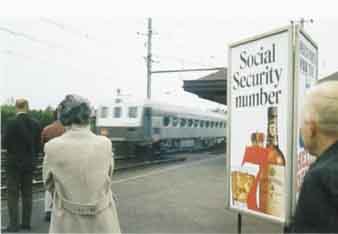
The success of the Shinkansen led the Pennsylvania Railroad,
one of the pioneers American electrification, to develop high-speed
trains for its New York to Washington route.
In June 1967, a test train races through New Jersey on
a press demonstration run. This experimental train was a predecessor
of the original Metroliner.
The prospect of truly high-speed service in the Northeast was never forgotten and simmered in the minds of transportation planners, politicians, and entrepreneurs. A variety of other high-speed schemes have also been seriously discussed, including the constructing new corridors in Florida, Texas, the Midwest, and between Los Angeles and Las Vegas. During the early 1990s Amtrak took renewed interest in high- speed trains, importing an X2000 train set from Sweden and an ICE (Inner City Express) train set from Germany for testing on the Northeast Corridor and nationwide tours. It was hoped this would generate interest in high-speed rail and this initiative was successful. High-speed rail service is finally coming to America. Financing was secured to upgrade portions of the Northeast Corridor, including an extension of overhead electrification from New Haven to Boston— thus eliminating delays caused by the locomotive change previously required at New Haven.
Acela Express
On November 16, 2000, Amtrak’s new high- speed service, known under the marketing name Acela Express, made its public debut with a successful press run. The Acela Express will serve Boston, New York, and Washington along the Northeast Corridor. Using new high-speed articulated tilting train sets, Acela Express will provide the fastest regular passenger service in North America operating at a maximum speed of 150 miles per hour. Additional service, known as Acela Regional and Acela Commuter will provide moderately fast service using locomotive hauled trains traveling at a maximum of 125 miles per hour.
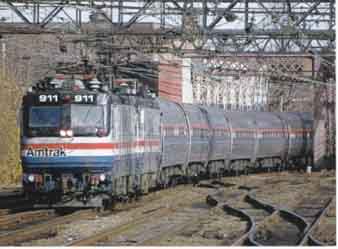
Amtrak has provided moderately high-speed service on the
Northeast Corridor for three decades. Beginning in 2000, the maximum
speed on some sections. Was boosted to 50 miles per hour. Trains will
still operate at much slower speeds on some sections of the Northeast
route, especially between New Haven, Connecticut, and New Rochelle, New
York, where tracks are shared with Metro-North commuter trains. Amtrak’s
Minute Man is led by a Swedish-designed AEM-7 electric at South Norwalk,
Connecticut.
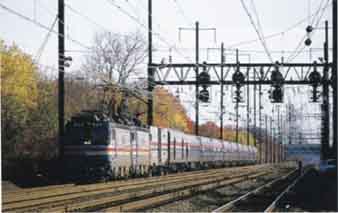
A pair of AEM-7s race along the Northeast Corridor at Newark, Delaware,
Amtrak has used the AEM-7 to provide service up to 125 miles per hour
since the early 1980s. Beginning in January 2000, electric service
was extended from New Haven to Boston,
thus allowing through locomotive hauled trains to operate the full
length of the Northeast Corridor without the need to change locomotives
at New Haven.
The introduction of Acela Express service is a significant development in the history of American railway transportation. The most dramatic speed increases are being obtained in the Boston to New Haven stretch where comparatively straight tracks, combined with the new tilting trains and extension of electrification over the entire route, will allow for a comfortable ride without the construction of an entirely new rail way. Acela Express is intended to make the Boston-to-New York run an hour faster than conventional trains prior to the upgrading, thus providing a three-hour run from South Station, Boston, to Pennsylvania Station, New York. Amtrak, which has already earned a significant market share in the Northeast, hopes that Acela Express will greatly improve its yearly ridership making it the first choice for many passengers in the Northeast.
The new Acela Express trains incorporated elements of successful European high-speed train design and employ a three—phase AC propulsion system based on modern TGV technology. Amtrak has styled the interior of Acela Express trains to meet with American approval. Riders will likely find Acela trains more spacious and more comfortable than comparable European or Japanese high-speed services. This is an especially important marketing consideration because Amtrak’s primary competition on this route are the commercial domestic airlines, which provide notoriously cramped accommodation in its shuttle services.
The Acela Express trains feature an articulated semi-permanent six-car train set with stream lined power cars on both ends. Each power car can produce 6,166 horsepower continuously, giving the train a total of 12,332 horsepower. The trains are designed to draw power from three different voltages used on different sections of the North east Corridor: 25 kilovolts 60 hertz from Boston to New Haven, 12 kilovolts 60 hertz from New Haven to New York, and 12 kilovolts 25 hertz from New York to Washington, D.C. (The disparity in voltage reflects the history of the North east Corridor electrification, as each section was electrified in a different era by different railroads.) The tilt mechanism uses technology developed in the 1970s and 1980s for Canada’s Light Rapid Comfortable (LRC) trains, operated by VIA Rail (the Canadian railway passenger provider). Initially 20 Acela Express trains are being built by a consortium of Bombardier and Alstom (formerly part of GEC-Alstom). (Note: although confusing, “Alstom” and “GEC-Alstom” are both correct. The h was dropped with the new name.) Assembly work was undertaken primarily at Bombardier’s American facilities in Barre, Vermont.

In 1992 and 1993, Amtrak imported advanced European
high-speed trains for testing and public demonstrations. Amtrak’s X2000
set is seen during setup procedures at Washington Union Terminal on November
6, 1992. The X2000 operated along with a German ICE-1 set on the Northeast
Corridor for several months to give passengers a feeling for high-speed
equipment. The result of these tests was the development of the Acela
Express trains, which incorporate European design elements.
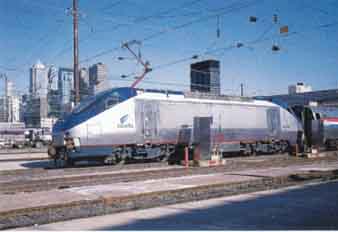
One of Amtrak’s new HHL high-horsepower locomotives for service
on Ace/a Regional trains, seen at 30th Street in Philadelphia in May
1999. The Ace/a marketing name will be used on most Northeast Corridor
trains, replacing older names such as the Metroliner. Only the Acela
Express will be allowed maximum speeds.
In addition to the Acela Express consists, Amtrak has ordered 15 new double-ended electric locomotives that feature streamlined front ends similar to the articulated consists. Designated descriptively HHL, for High Horsepower Loco motive, these locomotives will augment the existing AEM-7 fleet. They are rated at 8,000 horsepower and are intended for 125-mile per hour service.
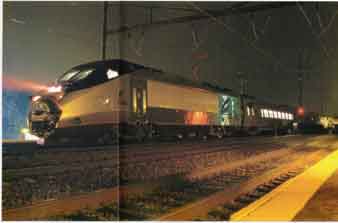
Early Sunday morning, August 1, 1999, the Acela Express and
its entourage of technical engineers take a quick break at a commuter
station in Pennsylvania while returning from a test trip to Delaware.
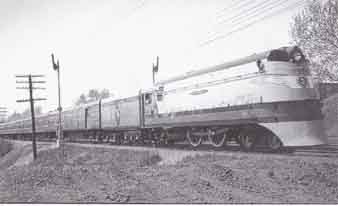 In 1935, Milwaukee
Road ordered Americas first built-new streamlined steam locomotives.
New York Central claims the first American streamlined steam locomotive,
a Hudson fitted with wind-resistant shrouds for service on its fast Hiawatha
trains between Chicago, Milwaukee, and the Twin Cities. These 4-4-2 Atlantics
regularly operated at 110 miles per hour. The Afternoon Hiawatha is seen
near St. Paul, Minnesota, on October 30, 1938.
In 1935, Milwaukee
Road ordered Americas first built-new streamlined steam locomotives.
New York Central claims the first American streamlined steam locomotive,
a Hudson fitted with wind-resistant shrouds for service on its fast Hiawatha
trains between Chicago, Milwaukee, and the Twin Cities. These 4-4-2 Atlantics
regularly operated at 110 miles per hour. The Afternoon Hiawatha is seen
near St. Paul, Minnesota, on October 30, 1938.
The debut of Acela Express service will put America back on the high-speed map, though with predominant European technology, and hopefully will set a precedent that encourages future development of an expanded North American high-speed network. Once travelers experience the benefits of high-speed rail, they find if difficult to deny its appeal. High-speed rail offers one of the safest, most efficient, and least environmentally damaging methods of travel. America with its clogged highways, desperate air pollution, and road-related carnage, needs a high-speed rail network to help satisfy its cultural passion for travel.
<< Prev. Next >>
Top of Page